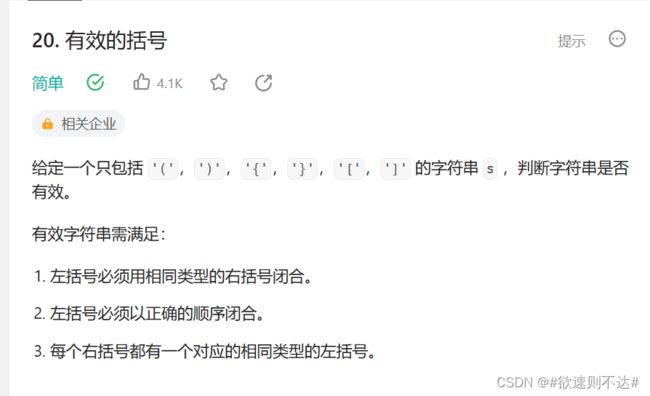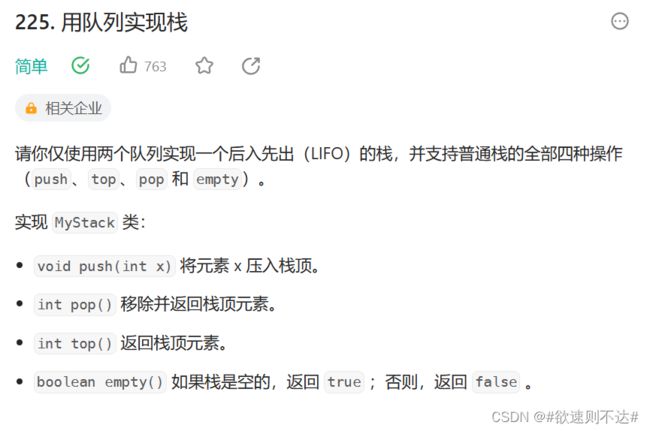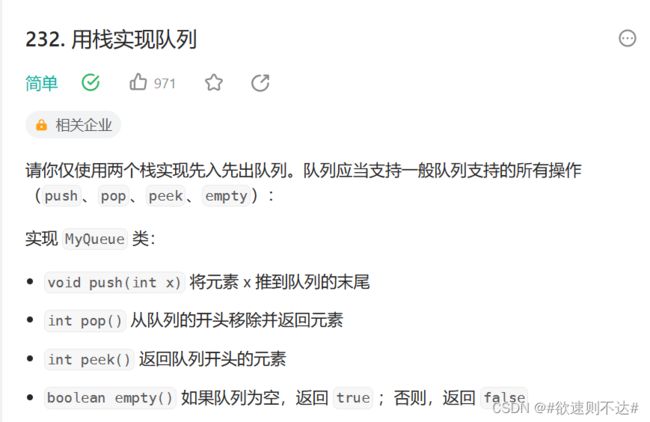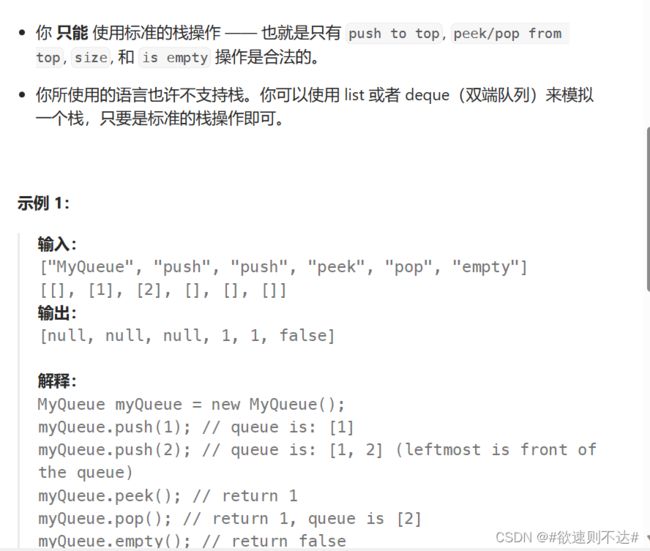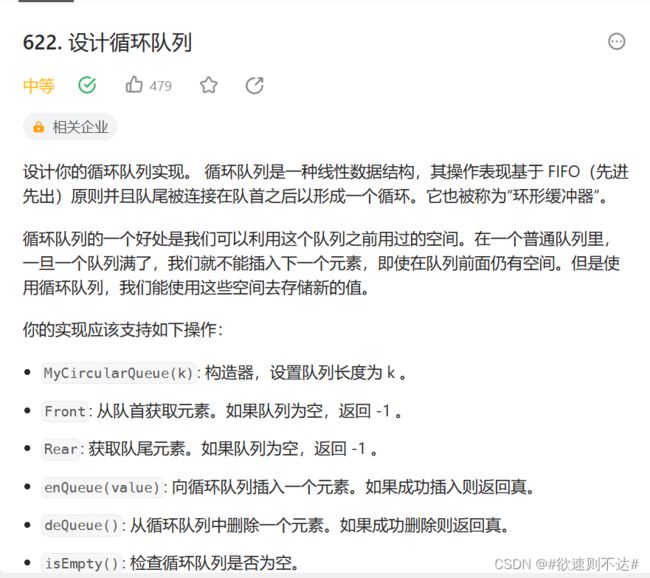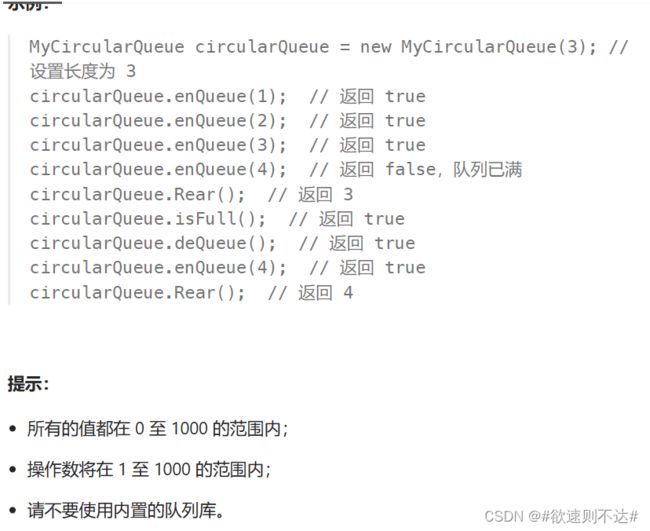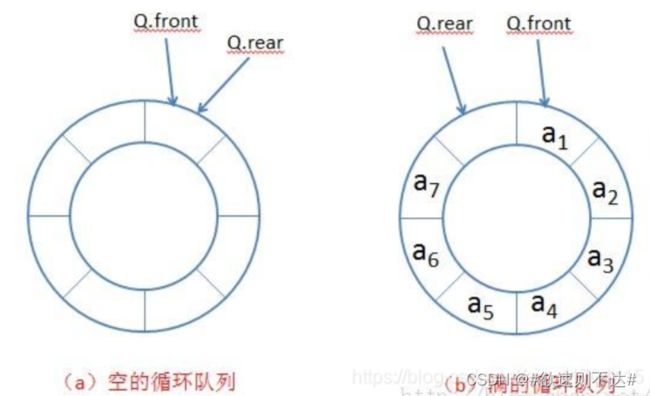栈和队列OJ
一、括号的匹配
题目介绍:
思路:
- 如果 c 是左括号,则入栈 push;
- 否则通过哈希表判断括号对应关系,若 stack 栈顶出栈括号 stack.pop() 与当前遍历括号 c 不对应,则提前返回 false。
- 栈 stack 为空: 此时 stack.pop() 操作会报错;因此,我们采用一个取巧方法,给 stack 赋初值 ?,并在哈希表 dic 中建立 key: ‘?’,value:’?’ 的对应关系予以配合。此时当 stack 为空且 c 为右括号时,可以正常提前返回 false
字符串 s 以左括号结尾: 此情况下可以正常遍历完整个 s,但 stack 中遗留未出栈的左括号;因此,最后需返回 len(stack) == 1,以判断是否是有效的括号组合
typedef int STDataType;
//动态存储结构
typedef struct Stack
{
STDataType *a;
int top;
int capacity; //容量
}ST;
void STInit(ST* ps); //初始化栈
void STDestory(ST* ps); //销毁栈
bool STEmpty(ST* ps); //判断是否为空
void STPush(ST* ps, STDataType x); //入栈
void STPop(ST* ps); //出栈
STDataType STTop(ST* ps); //取栈顶元素
int STSize(ST* ps); //返回栈元素个数
void STInit(ST* ps) //初始化栈
{
assert(ps);
ps->a = NULL;
ps->top = 0;
ps->capacity = 0;
}
void STDestory(ST* ps) //销毁栈
{
assert(ps);
free(ps->a);
ps->a = NULL;
ps->top = 0;
ps->capacity = 0;
}
bool STEmpty(ST* ps) //判断是否为空
{
assert(ps);
return (ps->top == 0);
}
void STPush(ST* ps, STDataType x) //入栈
{
assert(ps);
//扩容
if (ps->top == ps->capacity)
{
int newcapacity = ps->capacity == 0 ? 4 : ps->capacity * 2;
STDataType* tem = (STDataType*)realloc(ps->a,sizeof(STDataType)* newcapacity);
if (tem == NULL)
{
perror("malloc");
exit(-1);
}
ps->a = tem;
ps->capacity = newcapacity;
}
ps->a[ps->top] = x;
ps->top++;
}
void STPop(ST* ps) //出栈
{
assert(ps);
assert(ps->top>0);
--ps->top;
}
STDataType STTop(ST* ps) //取栈顶元素
{
assert(ps);
assert(ps->top > 0);
return ps->a[ps->top-1];
}
int STSize(ST* ps) //返回栈元素个数
{
assert(ps);
return ps->top ;
}
bool isValid(char * s)
{
char topval;
ST st;
STInit(&st);
while(*s)
{
if(*s=='('||*s=='['||*s=='{')
{
STPush(&st, *s);
}
else
{
if(STEmpty(&st))
{
STDestory(&st);
return false;
}
topval=STTop(&st);
STPop(&st);
if((*s=='}'&&topval!='{')
||(*s==')'&&topval!='(')
||(*s==']'&&topval!='['))
{
STDestory(&st);
return false;
}
}
++s;
}
bool ret=STEmpty(&st);
STDestory(&st);
return ret;
}二、队列实现栈
题目介绍:
typedef int QDataType;
typedef struct QueueNode
{
struct QueueNode* next;
QDataType data;
}QNode;
typedef struct Queue
{
QNode* head; //队头指针
QNode* tail; //队尾指针
int size; //元素个数
}Que;
void QueueInit(Que* pq); //初始化队列
void QueueDestory(Que* pq); //销毁队列
bool QueueEmpty(Que* pq); //判断队列是否为空
void QueuePush(Que* pq, QDataType x);//进队列
void QueuePop(Que* pq); //出队列
QDataType QueueFront(Que* pq); //取队头元素
QDataType QueueBack(Que* pq); //取队尾元素
int QueueSize(Que* pq); //返回元素个数
void QueueInit(Que* pq) //初始化队列
{
assert(pq);
pq->head = NULL;
pq->tail = NULL;
pq->size = 0;
}
void QueueDestory(Que* pq) //销毁队列
{
assert(pq);
QNode* cur =pq->head;
while (cur)
{
QNode* next = cur->next;
free(cur);
cur = next;
}
pq->head = pq->tail = NULL;
pq->size = 0;
}
bool QueueEmpty(Que* pq) //判断队列是否为空
{
assert(pq);
return pq -> head == NULL;
}
void QueuePush(Que* pq, QDataType x)//进队列
{
//尾插
assert(pq);
QNode* newnode = (QNode*)malloc(sizeof(QNode));
if (newnode == NULL)
{
perror("malloc");
exit(-1);
}
newnode->data = x;
newnode->next = NULL;
if (pq->tail == NULL)
{
pq->head = pq->tail = newnode;
}
else
{
pq->tail->next = newnode;
pq->tail = newnode;
}
pq->size++;
}
void QueuePop(Que* pq) //出队列
{
assert(pq);
assert(!QueueEmpty(pq));
if (pq->head->next == NULL)
{
free(pq->head);
pq->head = pq->tail=NULL;
}
else
{
QNode* next = pq->head->next;
free(pq->head);
pq->head = next;
}
pq->size--;
}
QDataType QueueFront(Que* pq) //取队头元素
{
assert(pq);
assert(!QueueEmpty(pq));
return pq->head->data;
}
QDataType QueueBack(Que* pq) //取队尾元素
{
assert(pq);
assert(!QueueEmpty(pq));
return pq->tail->data;
}
int QueueSize(Que* pq) //返回元素个数
{
assert(pq);
return pq->size;
}
typedef struct
{
Que q1;
Que q2;
} MyStack;
MyStack* myStackCreate()
{
MyStack*pst=(MyStack*)malloc(sizeof(MyStack));
QueueInit(&pst->q1);
QueueInit(&pst->q2);
return pst;
}
void myStackPush(MyStack* obj, int x)
{
if(!QueueEmpty(&obj->q1))
{
QueuePush(&obj->q1,x);
}
else
{
QueuePush(&obj->q2,x);
}
}
int myStackPop(MyStack* obj)
{
Que*empty=&obj->q1;
Que*nonEmpty=&obj->q2;
if(!QueueEmpty(&obj->q1))
{
nonEmpty=&obj->q1;
empty=&obj->q2;
}
while(QueueSize(nonEmpty)>1)
{
QueuePush(empty,QueueFront(nonEmpty));
QueuePop(nonEmpty);
}
int top=QueueFront(nonEmpty);
QueuePop(nonEmpty);
return top;
}
int myStackTop(MyStack* obj)
{
if(!QueueEmpty(&obj->q1))
{
return QueueBack(&obj->q1);
}
else
{
return QueueBack(&obj->q2);
}
}
bool myStackEmpty(MyStack* obj)
{
return QueueEmpty(&obj->q1)&&QueueEmpty(&obj->q2);
}
void myStackFree(MyStack* obj)
{
QueueDestory(&obj->q1);
QueueDestory(&obj->q2);
free(obj);
}
/**
* Your MyStack struct will be instantiated and called as such:
* MyStack* obj = myStackCreate();
* myStackPush(obj, x);
* int param_2 = myStackPop(obj);
* int param_3 = myStackTop(obj);
* bool param_4 = myStackEmpty(obj);
* myStackFree(obj);
*/三、栈实现队列
思路:
因为队列先进先出,栈先进后出,所以用两个栈实现队列。栈s1用来入队,栈s2用来出队。
入队:对入队的栈s1直接进行元素入栈。
出队:当出队的栈s2不为空时,s2直接出栈;若s2为空,将s1的元素都导入出队的栈s2里,然后s2进行出栈。、
在入队1、2、3、4后出队,如图所示:s1中的数据都入栈s2(s1,s2中的数据相同,顺序相反,例:s1中的栈底元素1出现在s2中的栈顶),此时s1的top==0(top表示栈中有多少元素,0代表栈中元素都已经出栈),s2的top==3(本来有4个数据,但栈顶元素已经出栈,所以为3).
typedef int STDataType;
typedef struct Stack
{
STDataType *a;
int top;
int capacity; //容量
}ST;
void STInit(ST* ps); //初始化栈
void STDestory(ST* ps); //销毁栈
bool STEmpty(ST* ps); //判断是否为空
void STPush(ST* ps, STDataType x); //入栈
void STPop(ST* ps); //出栈
STDataType STTop(ST* ps); //取栈顶元素
int STSize(ST* ps); //返回栈元素个数
void STInit(ST* ps) //初始化栈
{
assert(ps);
ps->a = NULL;
ps->top = 0;
ps->capacity = 0;
}
void STDestory(ST* ps) //销毁栈
{
assert(ps);
free(ps->a);
ps->a = NULL;
ps->top = 0;
ps->capacity = 0;
}
bool STEmpty(ST* ps) //判断是否为空
{
assert(ps);
return (ps->top == 0);
}
void STPush(ST* ps, STDataType x) //入栈
{
assert(ps);
//扩容
if (ps->top == ps->capacity)
{
int newcapacity = ps->capacity == 0 ? 4 : ps->capacity * 2;
STDataType* tem = (STDataType*)realloc(ps->a,sizeof(STDataType)* newcapacity);
if (tem == NULL)
{
perror("malloc");
exit(-1);
}
ps->a = tem;
ps->capacity = newcapacity;
}
ps->a[ps->top] = x;
ps->top++;
}
void STPop(ST* ps) //出栈
{
assert(ps);
assert(ps->top>0);
--ps->top;
}
STDataType STTop(ST* ps) //取栈顶元素
{
assert(ps);
assert(ps->top > 0);
return ps->a[ps->top-1];
}
int STSize(ST* ps) //返回栈元素个数
{
assert(ps);
return ps->top ;
}
typedef struct
{
ST pushst;
ST popst;
} MyQueue;
MyQueue* myQueueCreate()
{
MyQueue*obj=(MyQueue*)malloc(sizeof(MyQueue));
STInit(&obj->pushst);
STInit(&obj->popst);
return obj;
}
void myQueuePush(MyQueue* obj, int x)
{
STPush(&obj->pushst,x);
}
int myQueuePeek(MyQueue* obj) //取对头数据
{
if(STEmpty(&obj->popst))
{
while(!STEmpty(&obj->pushst))
{
STPush(&obj->popst,STTop(&obj->pushst));
STPop(&obj->pushst);
}
}
return STTop(&obj->popst);
}
int myQueuePop(MyQueue* obj)
{
int front =myQueuePeek(obj);
STPop(&obj->popst);
return front;
}
bool myQueueEmpty(MyQueue* obj)
{
return STEmpty(&obj->popst)&&STEmpty(&obj->pushst);
}
void myQueueFree(MyQueue* obj)
{
STDestory(&obj->popst);
STDestory(&obj->pushst);
free(obj);
}
/**
* Your MyQueue struct will be instantiated and called as such:
* MyQueue* obj = myQueueCreate();
* myQueuePush(obj, x);
* int param_2 = myQueuePop(obj);
* int param_3 = myQueuePeek(obj);
* bool param_4 = myQueueEmpty(obj);
* myQueueFree(obj);
*/四、循环队列
题目介绍:
设计一个队列,这个队列的大小是固定的,且队列头尾相连, 然后该队列能够实现题目中的操作。
那么是使用数组实现,还是用链表实现呢?我们接着往下看。
环形队列的几个判断条件
front:指向队列的第一个元素,初始值front=0
rear: 指向队列的最后一个元素的后一个位置(预留一个空间作为约定),初始值rear=0
maxSize: 数组的最大容量
队空:front == rear
队满:(rear+1)%maxSize == front
队列中的有效数据个数:(rear+maxSize-front)% maxSize
其中判断队列满的思想的话,可以看下图,因为是环形的,起初front=rear=0,每当添加元素时,将rear++,但是其实预留了一个长度没有用,比如定义的队列数组长度为5时,但是实际上可以使用的地址就是0,1,2,3,此时rear=4, 4这个空间用来判断队满的条件(rear+1)%maxSize==front
有了上面的铺垫就可以很轻松的写出下面的函数。
typedef struct
{
int *a;
int front;
int rear;
int k;
} MyCircularQueue;
MyCircularQueue* myCircularQueueCreate(int k)
{
MyCircularQueue*obj=(MyCircularQueue*)malloc(sizeof(MyCircularQueue));
//多开一个空间(浪费掉)为了区分空和满
obj->a=(int*)malloc(sizeof(int)*(k+1));
obj->front=obj->rear=0;
obj->k=k;
return obj;
}
bool myCircularQueueIsEmpty(MyCircularQueue* obj)
{
return obj->front==obj->rear;
}
bool myCircularQueueIsFull(MyCircularQueue* obj)
{
return (obj->rear+1)%(obj->k+1)==obj->front;
}
bool myCircularQueueEnQueue(MyCircularQueue* obj, int value)
{
if(myCircularQueueIsFull(obj))
{
return false;
}
obj->a[obj->rear]=value;
obj->rear++;
obj->rear%=(obj->k+1);
return true;
}
bool myCircularQueueDeQueue(MyCircularQueue* obj)
{
if(myCircularQueueIsEmpty(obj))
{
return false;
}
++obj->front;
obj->front%=(obj->k+1);
return true;
}
int myCircularQueueFront(MyCircularQueue* obj)
{
if(myCircularQueueIsEmpty(obj))
{
return -1;
}
return obj->a[obj->front];
}
int myCircularQueueRear(MyCircularQueue* obj)
{
if(myCircularQueueIsEmpty(obj))
{
return -1;
}
return obj->a[(obj->rear+(obj->k+1)-1)%(obj->k+1)];
}
void myCircularQueueFree(MyCircularQueue* obj)
{
free(obj->a);
free(obj);
}
/**
* Your MyCircularQueue struct will be instantiated and called as such:
* MyCircularQueue* obj = myCircularQueueCreate(k);
* bool param_1 = myCircularQueueEnQueue(obj, value);
* bool param_2 = myCircularQueueDeQueue(obj);
* int param_3 = myCircularQueueFront(obj);
* int param_4 = myCircularQueueRear(obj);
* bool param_5 = myCircularQueueIsEmpty(obj);
* bool param_6 = myCircularQueueIsFull(obj);
* myCircularQueueFree(obj);
*/